There is a number of ring flash adapters on the market today, from good quality branded products to not so great knock-offs. They all try, with a different degree of success, to turn your regular flash gun into a ring flash. In this review, we compare two of the most popular ring flash adapters: Orbis and Ray Flash.
Both adapters are priced similarly and aimed at the professional and near professional market. They are well-built to be able to withstand the challenges of working in the field. Orbis and Ray Flash deliver good results, but both also have weaknesses. Below you can find the main differences between the two units. For more details about each particular ring flash adapter, please refer to our Orbis review and Ray Flash review.
 |
 |
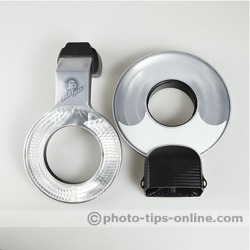 |
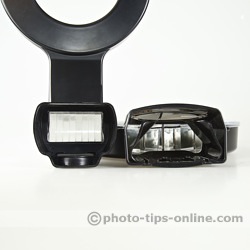 |
Light quality is the reason we buy these light modifiers. These ring flash adapters distribute the light from your flash gun around the lens, but in both cases, the light is not even along the whole ring.
The following two images are taken from about 3 feet (1 meter) from the subject. The flash power was adjusted, so that the center of the image is properly exposed.
 |
 |
As you can see, you get quite different lighting effects with these two adapters. With Ray Flash (right image), the light along the edges of the frame falls off much faster, whereas Orbis (left image) fills almost the whole frame. None of that is better or worse. It simply depends on what kind of lighting you want.
Also note that in the image taken with Orbis, the side shadows around the subject are "weaker" than the top and bottom parts of the contour shadow. The Ray Flash image shows the "dead spot" at the top where the shadow is barely visible, and the bottom part of the contour looks darker.
If you look at the two images below, you can see that Orbis (left) indeed projects less light along the left and right sides, but it does a relatively good job trying to reduce the hot spot. With the Ray Flash, it is also pretty obvious where the "dead spot" and the hot spot come from.
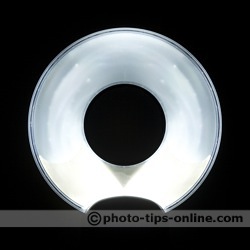 |
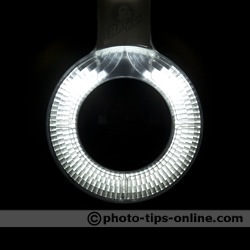 |
| Scores: | Orbis | 8/10 |
| Ray Flash | 7/10 |
How much light is lost by a flash light modifier is an important criterion, because it affects the effective range of the flash and the battery power consumption (meaning recycling times and number of flashes per charge). To compare the light loss, we've taken images with Orbis and Ray Flash positioned at the same distance from the subject, and the flash set to the same manual power value (with all camera settings being also identical). As you can see from the test images below, Ray Flash (right) is approximately 3 f-stops better than Orbis (at the center of the frame). It is a very significant difference, but that's the price Orbis has to pay for the larger ring and universal mount.
 |
 |
| Scores: | Orbis | 6/10 |
| Ray Flash | 9/10 |
The more flashes an adapter is compatible with the more flexibility you get when using it or, perhaps, lending it to a friend or colleague. It also affects the resale value, since it's easier to sell a device that fits multiple platforms. Orbis ring flash adapter is designed to be mounted on virtually any flash on the marker, while Ray Flash is not only made to fit a specific flash model but also a specific group of cameras. To be fair, we have to mention that Ray Flash might fit more flashes and cameras than specified by the manufacturer. That, however, may require some tweaking like, for example, wrapping some padding around the flash head.
| Scores: | Orbis | 10/10 |
| Ray Flash | 6/10 |
Using Orbis is very different from using Ray Flash. You have to hold Orbis with one hand while holding the camera and shooting with the other. This, however, adds an ability to quickly go from the ring type of lighting to off-camera lighting (using Orbis as a small softbox). Nevertheless, if you really do want to free your hands, there is a dedicated holder arm that you can purchase separately.
Ray Flash attaches to an on-camera flash gun, so you can keep shooting the way you normally do. There is a number of small quirks, however, that is worth mentioning. The weight of the adapter puts some stress on the flash head, so it might be a good idea to be a little more careful to prevent the potential damage to the flash head. Also, if you need to put your camera down, Ray Flash gets in the way, so you have to lay it on its LCD screen or take the adapter off. Changing lenses may also require taking the adapter off.
So, both units have some pros and cons, and whether you going to like these ring flash adapters or not really depends on your personal preferences. We would not give an edge here to either product.
| Scores: | Orbis | 8/10 |
| Ray Flash | 8/10 |
Both devices are pretty much color neutral and do not require any white balance adjustment. However, the bottom part of Orbis' lens seems to cause some yellowish cast that can be seen in the test image below. After using Orbis for some time, we haven't found that to be a real world problem, but it is still something to keep in mind.
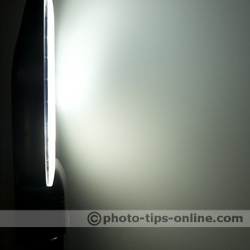 |
| Scores: | Orbis | 9/10 |
| Ray Flash | 10/10 |
Which ring flash adapter is the best? To us, there is no definite answer. It really depends on your personal preferences and shooting style. Both products make trade-offs and give up some things to shine in other areas. So, if you are trying to choose between Orbis and Ray Flash, think of the ways you would use it. What kind of light quality would work better for your applications? Does flash battery life matter? How many flash guns do you expect the adapter to be used with? What usability aspects are the most important to you? Hopefully, this article can help you answer these questions and make a right decision.